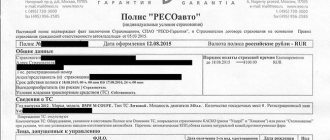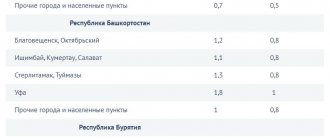Normative base
The Bank of Russia announced the changes. Draft Directive No. 53241 was published on the official website of the Central Bank of the Russian Federation, confirming all the adjustments. The regulatory act came into force on January 9, 2021.
Attention! If you have any questions, you can chat for free with a lawyer at the bottom of the screen or call Moscow; Saint Petersburg; Free call for all of Russia.
Regulations of the Central Bank on new MTPL tariffs for 2021
Every year, the state makes amendments to the mandatory type of auto insurance. The New Year 2021 was no exception, since the Central Bank of the Russian Federation introduced changes to the unified rules on compulsory motor liability insurance.
Documented all changes were published on the website of the Central Bank of the Russian Federation on December 29, 2021. This document is called instruction No. 5000-U, registered under No. 53241 with the Ministry of Justice of the Russian Federation.
Important! If, after studying the document, you have any questions about the new MTPL tariffs for 2021, then we suggest leaving a question in the “add a comment” section. You can also get an answer through an experienced specialist on our portal, who works via online chat.
What has changed in MTPL tariffs?
First of all, the changes affected the base rate of MTPL tariffs. It may vary depending on the vehicle category. The legal act specifies the maximum and minimum values. The company receives the right to independently determine the value of the indicator within the framework specified by law.
The adjustments entailed an expansion of the price corridor for MTPL policies. The minimum and maximum indicators have shifted by 20%. The increase will not affect owners of motorcycles and scooters. For this category of vehicles, the base tariff decreased by 10.9%.
Price corridors for MTPL policies in 2021.
| Category | Was (rub) | Became (rub) |
| A and E | 867-1579 | 694-1407 |
| B and BE | 3432-4118 | 2746-4942 |
| C and CE | 3509-4211 | 2807-7609 |
| D and DE | 2808-6166 | 2246-7399 |
The upper limit for passenger cars of legal entities is also reduced by 5.7 percent, to 2058 - 2911 rubles. For taxi drivers, the tariff corridor is expanding in both directions and will range from 4,110 to 7,399 rubles.
TB – base rate of compulsory motor liability insurance in 2021
The main essence of the new instructions of the Central Bank of the Russian Federation is to increase the cost of car insurance by increasing the tariff corridor of base rates. As before, the price of the policy is calculated using the usual formula by multiplying the required coefficients. The innovations affected the coefficients and base rates.
The range of basic car insurance rates for passenger cars expands by 20% up and down.
For clarity:
it was 3432 – 4118 rubles,
became 2746 – 4942 rubles
How has the price of the MTPL policy changed?
Initially, it appears that the base rate has remained virtually unchanged. However, insurers strive to set maximum rates. Innovations can lead to the fact that the cost of compulsory motor liability insurance policies will increase by 20%.
Subsequently, it is planned to legislatively regulate the specific value of insurance prices. So, if a car owner uses the services of one company, the cost can be reduced. However, this is just a suggestion. It is not fixed by regulations.
The coefficient changes
According to the previous rules, the price of an MTPL policy is calculated using the territorial principle of using a car, as well as taking into account its power. At the very beginning of the reform, this principle will remain - people from regions where the insurance situation is favorable (for example, the capital) pay less. Depressed regions are forced to fork out money – such as, for example, the Krasnodar Territory. In the future, this principle is planned to be abandoned - the cost of the policy will be based primarily on the driver’s experience.
The "base" of bets will be as follows:
- for motorists under 22 years of age and with less than three years of experience, compulsory motor liability insurance will increase by 1.8 times;
- for motorists over 22 years of age with more than three years of driving experience, a coefficient of 1 will be accepted, that is, the cost of the policy will remain unchanged.
In the fall of this year, fifty additional categories were introduced - previously there were four. Now people are divided according to age and driving experience.
For example, a motorist aged 25 to 29 with less than nine years of experience can count on a coefficient of 1.4, that is, the policy will become more expensive by 4%. Persons over 30 years of age with more than ten years of driving experience will pay even less for the policy (a coefficient of 0.96 will make it possible to reduce the price of the policy by 4%). That is, the reform will primarily affect young drivers who have recently received a license (coefficient of 1.87, price increase of 4.5%).
Photo: pixabay.com
What will happen to KBM in 2021?
The bonus-malus coefficient allows you to link the cost of insurance to compliance with traffic rules and the citizen’s driving style. By traveling without accidents, a citizen will be able to receive a discount. Its size reaches 50%. If a person is in an accident due to his own fault, in 2021 the indicator increases the cost of the MTPL policy. As a result, the price may increase by 145% of the standard price.
Previously, the KBM changed at the time of policy renewal. Now the indicator is calculated for the year. The coefficient is assigned to the individual. Before the changes were made, the calculation was made for the owner of the car and the driver. As a result, adjustments to the indicator during an accident could affect all persons who were included in the policy.
A citizen will be able to receive a discount, or the BMR will increase, if during the year the driver is involved in an accident through his own fault.
It does not take into account when the MTPL agreement was concluded.
New MTPL rules from January 9, 2021
In Russia, on January 9, the directive of the Central Bank of the Russian Federation came into force to expand the tariff corridor in compulsory motor liability insurance by 20% up and down. Thus, now the range of base tariff rates for passenger cars for individuals is now 2746-4942 rubles instead of the previously existing range of 3432-4118 rubles.
According to TASS, also starting from January 9, the division of drivers by experience and age into 58 categories instead of the four that existed before will be clarified. For drivers aged 16-21 with up to two years of driving experience, the maximum coefficient increases to 1.87 from 1.8, and the coefficient for “multidrive” policies increases from 1.8 to 1.87 (without limiting the number of drivers allowed to drive ).
Discounts for experience and age begin to apply, the largest - 7% (corresponding to a coefficient of 0.93) is established for drivers over the age of 59 with six years of experience. The previous MTPL system did not provide discounts for length of service and age.
In addition, according to the instructions, the document provides for a change in the calculation of the assignment of the bonus-malus coefficient (BMC). The KBM will be assigned to the driver once a year on April 1 and will not be recalculated during the year. Interfax explains that if on April 1, 2021, a car owner has several bonus-malus coefficients listed in the AIS RSA system, then he will be assigned the lowest of them. The new KBM system assigns the insurance history to the driver and does not allow it to be reset during a break in driving: all accumulated discounts will be retained.
A legal entity will be assigned a single one for all vehicles in the KBM fleet, which will significantly simplify the holding of competitions for concluding MTPL contracts.
Increasing the coefficient for OSAGO policies without restrictions
The driver has the right to purchase open insurance. It does not imply an indication of a specific list of persons who are allowed to drive a vehicle. Typically, such cars are used to conduct business. For the insurer, providing such a MTPL policy is an additional risk. Therefore, the cost of insurance is higher than the classic one. In 2021, the price is calculated taking into account the KO - the coefficient for a policy without restrictions.
Adjustments will lead to an increase in the indicator. It will increase to 1.87. Previously, the coefficient was 1.8. This will affect the price of compulsory motor liability insurance, increasing the cost of insurance without restrictions by 4%. However, the changes will only affect car owners who do not have the status of legal entities.
Insurance cover
In 2021, it is planned to introduce a system for calculating the amount of insurance coverage. Thanks to this innovation, the car owner will be able to independently decide how to insure his car:
- 1. 2 million rubles for material damage and damage to health and life;
- 2. 1 million rubles for material damage and damage to health and life;
- 3. 4 thousand rubles for material damage and 5 thousand rubles for damage to health and life.
It will also be allowed to determine the validity period of the policy. According to the new rules, it is now possible to obtain an insurance policy for three years at once (previously only for 1 year). This rule is positively assessed by car owners, but insurers do not agree with it.
New rules for calculating the age and length of service coefficient for compulsory motor liability insurance
In 2021, the price of insurance depends on the age of the driver and his experience. The more experienced a person is, the cheaper it will be to purchase an MTPL policy. Age and length of service are taken into account using the KVS coefficient. The indicator has been affected by significant changes.
| Initial standards for determining KVS until 2019 | |
| Index | Meaning |
| A citizen is under 22 years of age inclusive and received his license less than 3 years ago | 1,8 |
| The driver is under 22 years old, but has more than 3 years of driving experience | 1,6 |
| A person is over 22 years old and has been driving a car for over 3 years | 1,7 |
| The citizen's age exceeds 22 years, and his driving experience is 3 years. | 1,8 |
| Innovations from January 9, 2021 are valid in 2021 | ||||||||
| Age of the car owner (number of years) | Citizenship experience (number of years) | |||||||
| 0 | 1 | 2 | 3-4 | 5-6 | 7-9 | 10-14 | Over 14 | |
| 16-21 | 1,87 | 1,66 | ||||||
| 22-24 | 1,77 | 1,04 | ||||||
| 25-29 | 1,77 | 1,69 | 1,63 | 1,04 | 1,01 | |||
| 30-34 | 1,63 | 1,04 | 1,01 | 0,96 | ||||
| 35-39 | 0,99 | 0,96 | ||||||
| 40-49 | 0,96 | |||||||
| 50-59 | ||||||||
| Over 59 | 1,6 | 0,93 | ||||||
The gradation by age and length of service is increasing. The coefficient itself has undergone the following changes:
- For those under 22 years old who received their license less than 3 years ago, the rate has increased. Initially it was 1.8. Now the calculation takes into account the coefficient of 1.87.
- If a person over 30 years old has 10 years of driving experience, you can count on a small discount. The coefficient decreased by 0.04. Initially it was set at the level of one. Now the figure is 0.96.
After reading the table, the driver may consider the changes insignificant. To better understand the peculiarities of the influence of the coefficient on the cost of the MTPL policy, it is recommended to study an example. Let's say a citizen is 18 years old. He immediately passed his license, got a car and purchased compulsory motor insurance.
| Driver's age (Number of years since obtaining a license) | Was | It became |
| 18-20 (0-2) | 1,8 | 1,87 |
| 21 (3) | 1,6 | 1,66 |
| 22-27 (4-9) | 1 | 1,04 |
| 28-29 (10-11) | 1 | 1,01 |
| 30 (12) | 1 | 0,96 |
| Notional amount | 16 | 16,49 |
From the above example it is clear that over the course of 13 years, the citizen overpaid almost half the cost of the insurance policy. After this, the citizen’s length of service allows him to receive a 4% discount. The calculation will be made taking into account the FAC of 0.96. As a result, over the next 13 years the person will be able to repay the overpayment. At the age of 43, savings begin. The cost of the policy is reduced by 4% per year.
From January 9, 2021, changes also affected the procedure for determining driving experience. The law states that the indicator will be calculated starting from the moment of obtaining the right to drive a car of a certain category. Previously, the experience was general. This meant that it was determined based on the date of the earliest open category. Let’s say that at the age of 19 a citizen received a license to drive a vehicle of category B. Then, at the age of 40, a person passed the license of category C. It was considered that he had 21 years of experience.
In 2021, the indicator is calculated separately for each category. In the above example, the truck driver's experience will be 0 years. The date specified in the license is also taken into account. So, if a driver’s license was obtained on May 1, 2021, it is considered that the citizen’s length of service will be two years not on January 1, 2020, but on May 1.
How much will OSAGO cost in 2021 according to new tariffs?
Don’t think that motorists will have to pay more under the contract. Having studied the tariffs, it becomes clear that for experienced drivers who have been driving for several years, the rate has decreased. The minimum rate for the most common transport - cars - has also been reduced.
As a result of this, we can conclude that for experienced drivers the insurance policy will be cheaper.
Young road users who have just received their license will be forced to overpay a little, since the maximum age and length of service limit has increased to 1.87.
Calculation example
Let's take a look at the numbers to see how much a new OSAGO contract form will cost the client. It is worth noting that the formulas for calculating the insurance premium have remained unchanged.
Calculation provided:
- Registration – Moscow;
- Passenger transport, 98 horsepower;
- One driver, age 35 and 10 years of experience;
- 30% discount;
- The policy is issued for 1 year.
Insurance premium for the minimum basic indicator = 2746 * 2 (Moscow) * 30% (Discount) * 0.96 (Age and experience) * 1.1 (Power) * 1 (term) = 4,059.68 rubles . Insurance premium for the maximum basic indicator = 4942*2*30%*0.96*1.1*1 = 7306.25 rubles.
Cost at previous rates:
- According to the minimum basic threshold - 5,285.28 rubles;
- At the maximum value - 6,341.72 rubles.
To determine the amount of the insurance premium, according to personal data, we suggest using the calculator on our portal. A convenient service helps you get a quote without registration, completely free. Based on the results of the calculation, it is possible to proceed to the purchase procedure.
To generate the calculation, you should indicate in the calculator:
- vehicle data: make and model;
- year of car manufacture;
- owner's registration;
- insurance period;
- transport power;
- Contacts: mobile phone number and email address.
As soon as the data is entered correctly in the calculator, you should send a request to receive the cost.
Important! The calculator helps you select favorable insurance conditions only from large companies whose offices are located at the place of registration of the car owner. Having received offers, the car enthusiast will immediately see who is calculating the cost based on the minimum value and who is calculating the cost based on the maximum.
Accident-free driving rate
The indicator is calculated using the table enshrined in Federal Law No. 40 On OSAGO. She hasn't actually changed. When calculating the BMI, the insurer takes into account each indemnity and compensation payment.
If the coefficient does not correspond to the information contained in the AIS OSAGO, the adjusted indicator is used for the entire period of validity of the contract, during which the incorrect data was used. In simple terms, the insurer will set the minimum coefficient value. There was confusion earlier.
If a citizen purchases insurance for the first time, the BMI value is set at level 1. The indicator is determined annually. It is set for the period from April 1 to March 31 of the following year.
Claim procedure in OSAGO from January 1, 2021
Russian President Vladimir Putin signed a law extending the validity of the claims procedure in the MTPL. Corresponding changes have been made to the Federal Law on Compulsory Motor Liability Insurance. Let us remind you that the law on extending the claims procedure was adopted by the State Duma on June 16, 2021 and approved by the Federation Council on June 28. The document provides for the extension from July 1, 2021 to January 1, 2021 of the pre-trial procedure for the consideration of disputes under MTPL agreements.
This procedure provides that if there is a disagreement between the victim and the insurer regarding the latter’s fulfillment of its obligations (including the amount of the insurance payment), the victim, before filing a lawsuit, must re-apply to the insurer with justification for his claims, and the insurer will consider the claims of the victim obliged within 10 calendar days.
OSAGO tariffs may change from 2021
You can independently familiarize yourself with Law No. 40-FZ “On Compulsory Motor Liability Insurance”, latest edition 2021, .
Federal Law of April 25, 2002 N 40-FZ
An example of calculating the cost of an MTPL policy according to the new rules
The formula for calculating compulsory motor liability insurance is enshrined in Federal Law No. 40 of April 25, 2002 On the Automobile Citizen. It looks like this:
Cost of OSAGO = Basic tariff x CT x KBM x KVS x KO x KN x KM
The following coefficients are used in the calculation:
1. CT - territory coefficient. The indicator is set for the area in which the car is registered.
The more vehicles drive on the region's roads, the higher the indicator. This is associated with an increased risk of getting into an accident.
2. KBM - bonus-malus coefficient. Depends on the number of accidents that occurred due to the driver’s fault during the reporting period. The indicator may reduce the cost of insurance or lead to an increase in prices. The value is determined in accordance with the table established by law.
3. KVS - coefficient of age and experience. The younger the driver, the higher the risk of being in an accident. The chance of an insured event also depends on the number of years during which a person has the right to drive a car.
4. KO - limited use coefficient. Depends on the number of persons authorized to drive a vehicle.
5. KN - coefficient of violations. The indicator is provided for in Article 9 of the Federal Law on Compulsory Motor Liability Insurance.
6. KM - power factor. Depends on the strength of the car engine.
The law defines a cost corridor within which the insurance company has the right to set a basic tariff. In practice, organizations almost always use the maximum indicator. OSAGO is considered an unprofitable type of insurance. In this way, companies seek to compensate for possible costs.
To understand the price of an MTPL policy at the new 2020 tariffs, it is recommended to study the example. It is better to look at three categories of drivers at once:
- the average citizen who owns a budget vehicle;
- a young car enthusiast who recently bought a powerful car;
- an experienced elderly person using a low-power vehicle.
The reform of the 2021 OSAGO tariff price corridor was carried out in order to increase the cost of the policy for novice drivers and reduce it for experienced drivers. Persons who comply with traffic rules can also count on a discount. Studying examples allows us to understand whether legislators succeeded in achieving their goals.
Let's say that in the first example the average citizen lives in the city of Sochi. For this region, the CT is set at 1.2. A person owns a Kia Rio car. The vehicle's power is 107 horsepower. KM will be set at 1.2. The driver purchased a one-year limited policy. Only the owner of the car is included in the insurance. He turned 30 years old. Of these, a person has a driver’s license for 5 years. The accident-free experience is 3 years. The BMR was set at 0.85. The insurer has set a maximum base rate. This phenomenon is the most common in practice. As a result, the cost of the policy at the new MTPL tariffs for 2021 will be:
- old tariff - 4118×1.2×0.85×1×1×1.2 = 5040.43 rubles;
- new tariff - 4942×1.2×0.85×1×1.04×1.2×1 = 6290.97 rubles.
The base coefficient plays a decisive role. Its increase by 20% led to a slight increase in the cost of the MTPL policy.
Let's look at another example. Let's say a young driver from Moscow purchased a BMW X5 with 420 horsepower. KRP is 2, and KM is 1.6. Let's say a citizen purchased an unlimited policy for a period of one year. The driver was 21 years old. Of these, the person has the right to drive a vehicle for 2 years. Last year, a young driver was involved in an accident. He was found guilty of the incident. As a result, the BMR was set at 1.55. Additionally, there was a violation of Federal Law 40 on OSAGO. The citizen provided false information to the insurance company, which resulted in an underestimation of the cost. As a result, the insurance price will be:
- old tariff - 4118×2×1.55×1.8×1.6 = 36765.5 rubles;
- new tariff - 4942×2×1.55×1.87×1.6×1.5 = 68757.05 rubles.
The amount is huge. However, the insurer has the right to demand its provision.
Let's imagine that the third driver lives in Buryatia in a small locality. Krp for this area is 0.6. The citizen has a Renault Logan car, the power of which is 80 horsepower. KM is set at 1.1. A limited OSAGO policy was purchased for a period of one year. The owner of the car is included in the document. He is 55 years old. Of these, the citizen has been driving a vehicle for 25 years. The driver managed to go 15 years without an accident. The BMF is set at 0.5. To buy a policy, you will need to pay:
- old tariff - 4118×0.5×0.6×1×1.1×1 = 1358.94 rubles;
- the new tariff is 4942×0.5×0.6×0.96×1×1.1×1 = 1565.63 rubles.
From the above examples, it is clear that the cost of insurance increases both for experienced motorists who follow traffic rules and for young drivers who violate current regulations. We can say that in 2021 the price of the policy has risen. The hardest part will be for inexperienced car enthusiasts. For them, the cost of the policy can almost double.
OSAGO 2021: all important system changes in one article
Due to constantly emerging news about various proposals in the system of reforming compulsory motor insurance, not everyone has time to figure out what compulsory motor liability insurance 2021 will be like.
Dear OSAGO? Restore KBM now
and stop overpaying insurers!
The service will send an application to RSA. Recovery time for KBM: from 12 hours. Find out more
We decided to talk about the most important changes, listing them in a list and giving short explanations for each.
- The KBM will change. Now it is tied to the car and gives drivers the right to a discount if they drive without causing an accident. Next year it will not matter how many vehicles a driver periodically drives, his MSC will be personal, and it will be reviewed annually. By installing a new “bonus-malus” calculation system, drivers who have several coefficients will be allowed to keep the most profitable one.
- A detailed age-experience coefficient will appear to provide individual discounts. They promise literally up to twenty or more gradations of drivers according to this principle. It is possible that up to a 5% difference in discount will be established between them, but at the initial stage, and then the system will further adapt to the individual offer through this coefficient.
- The tariff corridor will change in the direction of reducing the lower limit of the base cost of the policy and increasing the upper limit. The change will be 20%. This will make it possible to immediately make offer prices profitable for insurers to clients and punishment prices unprofitable.
- There will be no need to have a compulsory motor liability insurance policy or even a printout of it on hand. It will be enough to know the insurance number, so the paper version will still remain a popular way of proving that compulsory motor liability insurance has been issued: not everyone will want to remember the policy number; it will at least need to be written down on paper. An option with a photo of the policy in your smartphone is also suitable.
- In insurance contracts, those clauses that relate to the choice of a beneficiary (heir) will be worked out in the event that the policyholder dies as a result of an accident.
- Russian drivers will be protected from problems when they get into an accident with road users who arrived in their cars from abroad. Such drivers do not have compulsory motor liability insurance, but they will be required to purchase insurance before entering the territory of the Russian Federation, and customs officers will monitor the availability of the policy at the border.
- The car power factor will be cancelled. Over the years of statistical observations, the fact that it is high-powered cars that often get into accidents has not been confirmed. As it turned out, powerful cars, in addition to a large amount of horsepower under the hood, also have options that help the driver cope with emergency situations on the road and prevent an accident.
- The territoriality coefficient will be abolished. For policy pricing, it will not matter where the car is registered or in what region.
- The Central Bank will expand its control functions in the MTPL system; it will be allowed to monitor how much profit insurance companies receive and how agents work.
- They will increase the sums insured, but will make this offer complementary to the basic insurance payments, and the increased ones will not be offered to everyone, but only to clients who are profitable for insurance companies.
- The validity period of compulsory motor liability insurance policies will be revised, introducing the possibility of insuring liability for the period required by the driver.
There are other possible changes, but they are contradictory, therefore, it is not a fact that they will be introduced in 2021; most likely, some of them will have to be modified. And the innovations listed above were approved by the majority of participants in the interdepartmental discussion on the reform of compulsory motor liability insurance.
Renew OSAGO at the best price!
Nuances
In 2021, a pilot project is planned to be launched in several regions of the Russian Federation to identify car owners who neglect the need to purchase compulsory motor insurance. The procedure will not be carried out by employees of the Ministry of Internal Affairs, but by new video cameras. They are equipped with an intelligent information processing system. Federal Law No. 40 states that the absence of compulsory motor liability insurance or a violation in the process of its registration entails the imposition of a fine. The norm applies to all categories of citizens.
The exception is cars that were received less than 10 days ago. This fact must be confirmed by the relevant document. In 2021, the following fines have been established for neglecting the need to purchase compulsory motor liability insurance - 500 rubles, if insurance is present, but issued with violations, or 800 rubles, if the policy has not been purchased. A fine is levied on a citizen every time he is within the camera's coverage area. Collection may increase to 8,000 rubles. Today, a bill to tighten punishment is being considered in the State Duma.
It is permissible to reduce the amount of the fine. To do this, you need to deposit funds within 20 days from the date of imposition of the penalty. The easiest way to get insurance is to use trusted resources and contact the insurer directly. If a compulsory motor liability insurance policy is issued via the Internet, a deferment is provided. The electronic document will become valid only 3 days from the date of purchase. This excludes the possibility of issuing compulsory motor liability insurance after an accident. Similar precedents have been observed previously.
New bills on compulsory motor liability insurance
On December 24, a bill was introduced in the State Duma that would require that not only the car, but also the specific driver have a compulsory motor liability insurance policy. This will allow policy holders to drive any car they own as long as it fits the category specified in the policy. That is, you will not need to take out separate policies for each car - you just need to insure yourself personally.
In addition, such a policy would also apply to other people’s vehicles, but subject to written consent (power of attorney) or personal presence of the car owner. Again, provided that the insurance categories and the vehicle match.
In any case, the policyholder will have to pay an insurance premium for such a policy, based on three indicators - accident rate, age and length of service.
Unfortunately, the fate of this bill is still unknown. Perhaps in 2021 he will be rejected or accepted as promising. We will watch the development of events.










